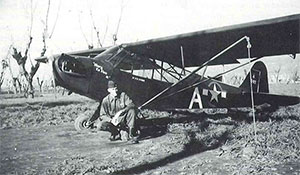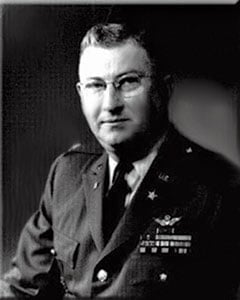
Historical Perspective / By Mark Albertson: On November 9, 1942, Captain Ford “Ace” Allcorn led a flight of three L-4 Cubs off the deck of the fleet carrier Ranger (CV-4). Allcorn’s ill-fated effort marked the combat debut of Army Aviation in World War II.1 Despite the setback at Casablanca, intrepid Air Observation Post fliers would go on to prove that Army Aviation was here to stay.
 Lt. Payne S. Lysne helped to fly in supplies of blood to the wounded at Anzio, January 1944. / ARMY AVIATION MAGAZINEColonel Charles E. Hart, II Corps artillery officer, thought it prudent to organize Air OP assets by assigning an air officer. Lieutenant Delbert L. Bristol joined Hart’s staff. Bristol virtually created a position. The energetic aviator organized flight records; assigned missions to planes and pilots; established a system of parts supply to alleviate shortages, picking up the slack from the Army Air Forces which was responsible for same. What Bristol did was to bring organization to the business. His attention to detail, energy and organizational skills helped in no small measure to sell the Air Operations concept in North Africa. Such was Bristol’s success that he was named air officer of First Army and, was detailed with planning and organizing much of the Air OP effort for OVERLORD.2
Lt. Payne S. Lysne helped to fly in supplies of blood to the wounded at Anzio, January 1944. / ARMY AVIATION MAGAZINEColonel Charles E. Hart, II Corps artillery officer, thought it prudent to organize Air OP assets by assigning an air officer. Lieutenant Delbert L. Bristol joined Hart’s staff. Bristol virtually created a position. The energetic aviator organized flight records; assigned missions to planes and pilots; established a system of parts supply to alleviate shortages, picking up the slack from the Army Air Forces which was responsible for same. What Bristol did was to bring organization to the business. His attention to detail, energy and organizational skills helped in no small measure to sell the Air Operations concept in North Africa. Such was Bristol’s success that he was named air officer of First Army and, was detailed with planning and organizing much of the Air OP effort for OVERLORD.2
Quickly the Air Ops were providing services beyond that of directing artillery fire. For instance, between April 23 to May 8, 1943, aviators manning 31 aircraft logged 715 missions, broken down thus: Artillery Fire Direction, 97; Supply and Courier, 231; Reconnaissance, 167; Route Column Control and Camouflage Checks, 88 and Unit Training, 132. Only 13.5 percent of these missions were for the direction of artillery fire. And most important, not one man was lost.3
Just how ambidextrous Army Aviation was becoming can be seen in January 1944, Anzio. The slugfest on the hotly contested beaches caused heavy casualties among the assault forces. Blood was in desperate need. Lieutenants Paynee O. Lysne and Richard W. Blake flew in 50 pints. “In less than 24 hours after the plea had been broadcast, life-giving blood was being administered.”4
Aviators helped to fend off fierce German counterattacks. Captain William H. McKay of Fifth Army, spotted a German force moving on the beaches. Some 2,400 troops backed by tanks were suddenly bludgeoned by a 5,000 round downpour of American steel. A German officer later captured, offered that casualties were upwards of fifty percent as a result of the lethal cooperation between McKay and American gunners.5
 Army Aviation Hall of Famer, Delbert Bristol, brought organization to Army Aviation during the Tunisian campaign, 1942-43.Normandy, June 1944, some of the Air OPs entered the Continent by flying their Cubs over the Channel. The L-4, though, lacked the fuel capacity. The remedy was an oxygen tank strapped to the back seat, with a fuel line running to the main tank, giving the L-4 twenty gallons for the dash to France.6
Army Aviation Hall of Famer, Delbert Bristol, brought organization to Army Aviation during the Tunisian campaign, 1942-43.Normandy, June 1944, some of the Air OPs entered the Continent by flying their Cubs over the Channel. The L-4, though, lacked the fuel capacity. The remedy was an oxygen tank strapped to the back seat, with a fuel line running to the main tank, giving the L-4 twenty gallons for the dash to France.6
Air OPs quickly set up shop on French cow pastures; and here a hazard quickly manifested itself: Mines. At the same time the Ground Forces were gaining experience in employing the Air OPs, the Germans were learning, too. As minefields were sown across empty cow pastures, aviators sought out clearings occupied by grazing cattle.
Some of the toughest fighting of the post-Normandy drive across France was in the hedgerows of the Cotentin Peninsula, a.k.a. the Bocage. Hedgerow combat ate up infantrymen like peanuts. “A rifle company after a week of combat often numbered less than one hundred men; sometimes it resembled a reinforced platoon. Casualties among infantry officers in line companies were particularly heavy in the hedgerow country, where small-unit initiative and individual leadership figured so largely.”7
Air OPs provided that high point of observation to see beyond the next hedgerow. German flak and small arms proved more than just a minor nuisance in this type of combat. Flights made on the American side of the line had its hazards, too. American gunners taking German positions under fire downed a Cub piloted by 1st Lieutenant Alfred R. Howard of the 90th Infantry Division. Killed, too, was Howard’s observer, Lieutenant William G. Winder.8
Air OPs flew antiflak patrols. Army aviator Hughes Rudd provides a glimpse into flak suppression: “. . . German flak crews were very cautious in shooting at the L-4s, but of course there were times when they thought the odds in their favor. The 88s usually fired a ‘ladder’ of six rounds, apparently hoping you’d fly into one of the three pairs . . . But the muzzle flash of the 88 was so large and bright that you couldn’t miss it. In the Vosges in France I was flying near Bitche when six brown bursts appeared off my right wing . . . I had seen the muzzle flashes from a village across the Rhine . . . I radioed the 93rd’s fire direction center and gave them the coordinates, they poured thirty-six rounds into the village; there were no more ‘ladders’ from that quarter.”9
Wire laying, courier service, route column control, medical evacuation, supply runs, cabbie service for brass, dusk to dawn patrols along the front lines, observation and reconnaissance . . . why the ubiquitous Cubs flew top cover for the Red Ball Express, as these vulnerable truck convoys wound their way through the French countryside. Air OPs warned of pockets of bypassed Germans, reported obstacles and dispatched mechanics to broken down trucks.
Through the crucible of combat, gallant aviators established Army Aviation beyond the Air Observation Post concept; providing a basket of tactical aerial services that helped the foot slogger decide the issue on the battlefield. But such a litmus test does not come without cost. And it is to those who were lost that this commemoration is reverently dedicated.
Notes
1. See pages 64-66, “Baptism of Fire,” Army Aviation, November 30, 2012, by Mark Albertson.
2. OVERLORD was the Allied codename for the June 6, 1944 Normandy operation.
3. See page 652, “Air OPs in Tunisia Campaign,” The Field Artillery Journal, Vol. 33, No. 9, September 1943, by John E. Coleman.
4. See page 43, “The War Years: North Africa, Sicily, Italy,” Part VI, The Army Aviation Story, by Richard K. Tierney.
5. See page 105, “The Most Lethal Plane in the World,” Mr. Piper and His Cubs, by Devon Francis.
6. See page 93, chapter ten, “L-Bird Oddities,” Box Seat Over Hell, by Hardy D. Cannon.
7. See page 175, chapter IX, “The Conclusions,” Breakout and Pursuit, United States Army in World War II, European Theater of Operations, Center of Military History, United States Army, Washington, D.C., by Martin Blumenson, 1961.
8. See page 208, chapter 6, “The European Theater of Operations, June 1944-September 1945, Eyes of Artillery, by Edgar F. Raines.
9. See page 7, “When I Landed the War Was Over,” American Heritage, Vol. 32, Issue 6, by Hughes Rudd.
Mark Albertson is an award winning historian and contributing editor to ARMY AVIATION magazine.This is Part I of a two-part series commemorating the 70th anniversary of V-E Day in World War II.










